MARCH 2020
Lenses for Wide Field Imaging
An article in the author’s Astronomy Digest https://www.ianmorison.com
Introduction
Normallythe purchase of a digital camera includes a ‘kit’ lens. This is normally a zoom lens giving a focallength of 28 to 70 mm for a full frame camera or 16 to 50 mm for an APS-Ccamera. These tend to have a maximumaperture of f/3.5. To improve the imagequality across the frame it is often best to stop down a lens by one or one anda half stops, and so the use of kit lenses will require longer exposures thanif a wider aperture prime lens were used. In the past, the image quality of zoom lenses was not up to that of asimpler prime lens, but with multi-coating on the lens elements and the use ofaspherical and high refractive index glass elements, these are now far betterand one of my very best images (described in the chapter ‘Taking a stars trailsimage’) was taken using an excellent, very wide angle, Sigma zoom lens. In addition, the latest sensors are moresensitive and have less noise than those employed in the past so higher ISOscan be used, so compensating somewhat for the lower apertures.
But, forserious wide field astrophotography prime, fixed focal length, lenses arelikely to be best; they will tend to employ fewer glass elements so there willbe less internal scattering so that the contrast should be higher and theoptical aberrations less. There is onegreat advantage when using prime lenses for astrophotography as they will beused in manual focussing mode so that second hand manual prime lenses can beused which can be bought for far less than new autofocus lenses. Older lenses were usually made of metalrather than plastic so can last for many years. Another good feature of these old lenses is that they usually have a‘hard stop’ at infinity focus.
If using aDSLR, lenses made for a particular make will usually need to be designedspecifically for use with it, either by the camera manufacturer itself or bycompanies such as Sigma or Tamron. Thereis one exception in that Canon cameras have a lesser flange to sensor distanceand a wider throat than Nikon cameras and so that manual Nikon lenses can beused with an adapter on a Canon body. [Ican thus use Nikon lenses with my H-alpha modified Canon 1100D.] If, instead, mirrorless cameras are used withthe use of adapters, then as well as lenses made specifically for the cameramake, lens designed for virtually any DSLR (digital or film) or rangefindercamera systems can be used. This is why,if one were going to specifically buy a camera where astrophotography was to bepart of its use, a mirrorless camera would be a better buy. I have a wide range of manual prime lensesranging from Leica and Zeiss rangefinder lenses to Sony and Nikon DSLR lenseswith focal lengths ranging from 8mm to 400 mm. As described below, such a range enables a focal length and hencecaptured field of view to be chosen suitable for the area of the heavens thatis to be imaged.
One of thebest manufacturers of these adapters is ‘K&F Concept’ which, when theaperture is only controlled from within the camera, will allow one to controlthe aperture of the attached lenses. They are beautifully made and cost~£25. I have them to mount Nikon, SonyA-mount and Contax G lenses onto the Sony A5000 camera that I use for much ofmy wide field imaging. When manuallenses having the iris control on the lens body are to be used, simpler andhence cheaper adapters can be used. Forexample, for use with Leica 39mm screw mount lenses and m42 screw mount lenses,these can be bought for less than £10.
Using Full Frame, FX, lenses on APS-C or Micro4/3, DX, cameras
I suspectthat the use of legacy full frame lenses on mirrorless APS-C or Micro 4/3cameras will be very common − I use both Nikon and Zeiss full frame lenses onmy Sony A5000 camera. There are threeadvantages: as only the central part of the image circle is being used,vignetting should not be an issue, the sharpness should be uniform across thefield of view and the problem of coma that can often be seen in the cornerswhen used with a full frame camera should not be present or certainly farreduced. Due to the crop factor, thefield of view will be smaller than when used on a FX sensor.
There isonly one small caveat. If a lens isdesigned to give a smaller image circle then it might be that the resolution ofthe lens can be somewhat higher but I doubt that this would have much effect onthe use of a lens when astroimaging.
Using DX lenses on FX cameras
This maysound nonsensical but it is not necessarily so as usually the field of view isincreased. Assume a DX lens can give aperfect image across the Nikon APS-C sensor which is 23.6 x 15.6 mm in size. Thenwhen used on a FX camera, an area of 23.6 x 23.6mm on the sensor should give aperfect image. This has an area which is1.5 times greater than when the lens is used on a DX sensor. Not to be sniffed at. I tried this out with a kit lens at itsmaximum aperture of f/4 and found that it performed even better than I hadexpected, with less cropping required giving an area 1.75 times greater thanwhen used on a DX sensor. Somewhat surprising.
The required crop of a DX f/4 kit lens at fullaperture on an FX sensor.
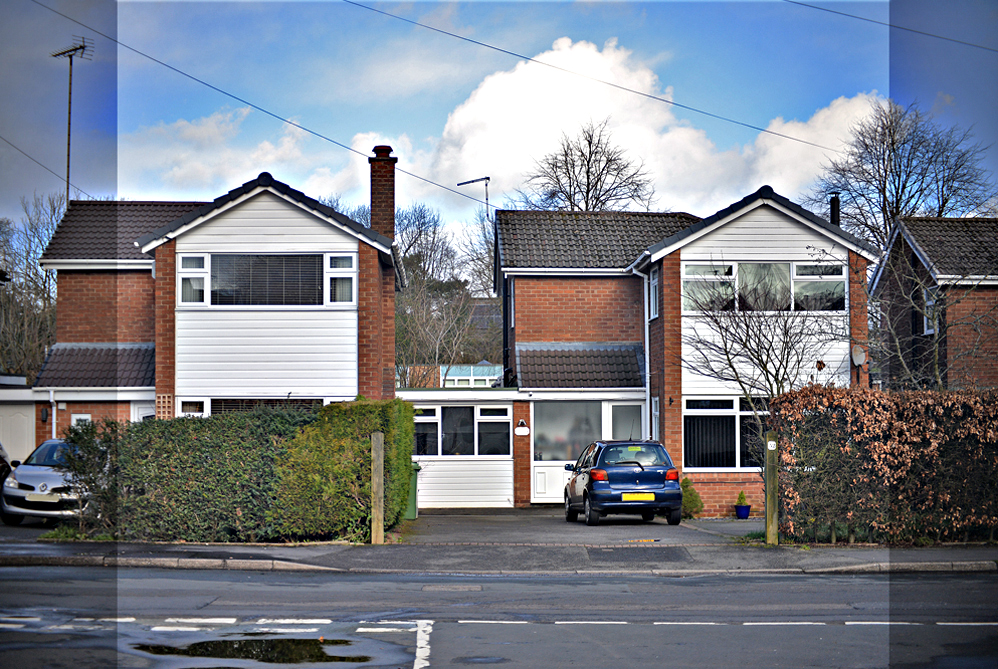
With a fewlenses the improvement can be even greater. For some reason, I mounted the Nikon 35mm f/1.8 DX lens bought for usewith my Nikon D7000 (and S-BIG CCD camera) onto my FX Nikon D610 camera and wasvery surprised with the results. Yes,when stopped down somewhat, there was still some vignetting in the corners butthis was easily correctable in Photoshop. The image quality did fall off in the corners,but using a crop to slightly reduce the horizontal width gave a very acceptable~37 mm equivalent lens and an effective sensor area of ~30 x 24 mm which isclose on twice the area of the DX sensor. Looking on the web I found that others had found the same thing.
The required crop of a Nikon DX 35mm f/1.8 primelens at f/4 on an FX sensor.
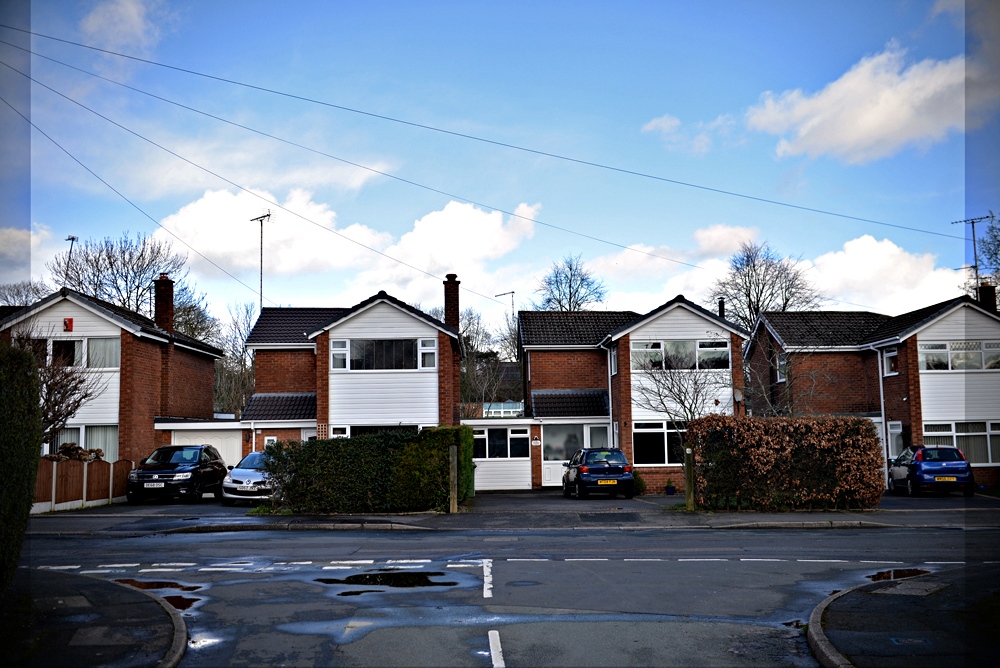
This wouldbe an excellent lens to purchase for use on a Nikon DX camera or with anadapter for use with DX mirrorless cameras and could be even more useful if, atsometime in the future, a full frame Nikon or mirrorless FX camera were to be purchased.
I have found one other interesting example. I have the excellent Samyang 8mm fisheye lens that perfectly covers the Nikon DX sensor (APS-C) giving a really sharp image. It is obvious that, if used on a FX sensor, an almost full circular image will result − providing that the lens hood is removed. So this will be far better for full sky imaging, perhaps to capture meteor trails. [Coupled with the High Sensitivity Sigma A7s full frame camera this is the perfect (and unbeatable) combination for all sky imaging at night.]
The Samyang 8 mm fisheye lens on an APS-Csensor (above) with its image on a full frame sensor below
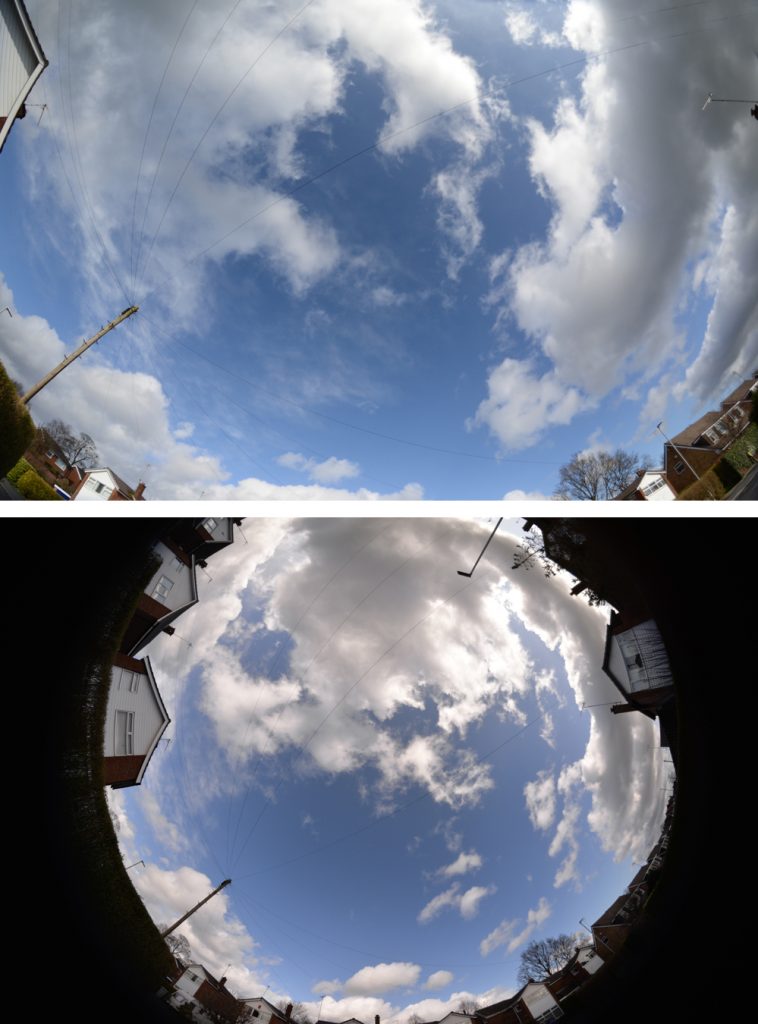
Capturing a Meteor
The lens was used to take all sky images over two nights around the Perseid Meteor Shower in August 2022 whilst a Full Moon was in the sky. Around 600 images were taken and only one captured a meteor – and it was a sporadic meteor not a Perseid.
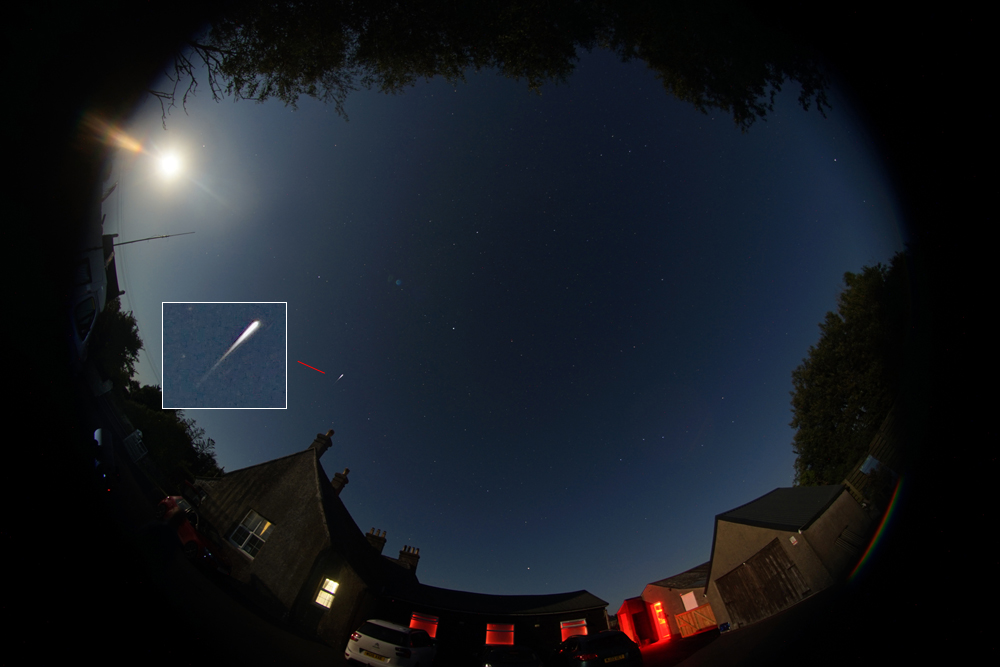
Fields of View
The pointof having a variety of focal lengths available is that a suitable lens can bechosen to cover the desired field of view. The program ‘Astronomy Tools Field of View Calculator’ can be used to findthe field of view that will be given with a particular lens/cameracombination. In ‘Imaging Mode’, a targetobject is selected along with the camera and focal length of the lens. If the camera to be used is not in the wideselection of cameras given in the list, one can simply chose one with a similarsized sensor. For example, for a FXsensor choose the Nikon D750 and, for a DX sensor, the Nikon D7000.
The images below give the approximate field of view provided by full frame equivalent lenses so, when using an APS-C sensor, one would use a focal length ~2/3 less.
Sirius and Orion with a 45mm lens
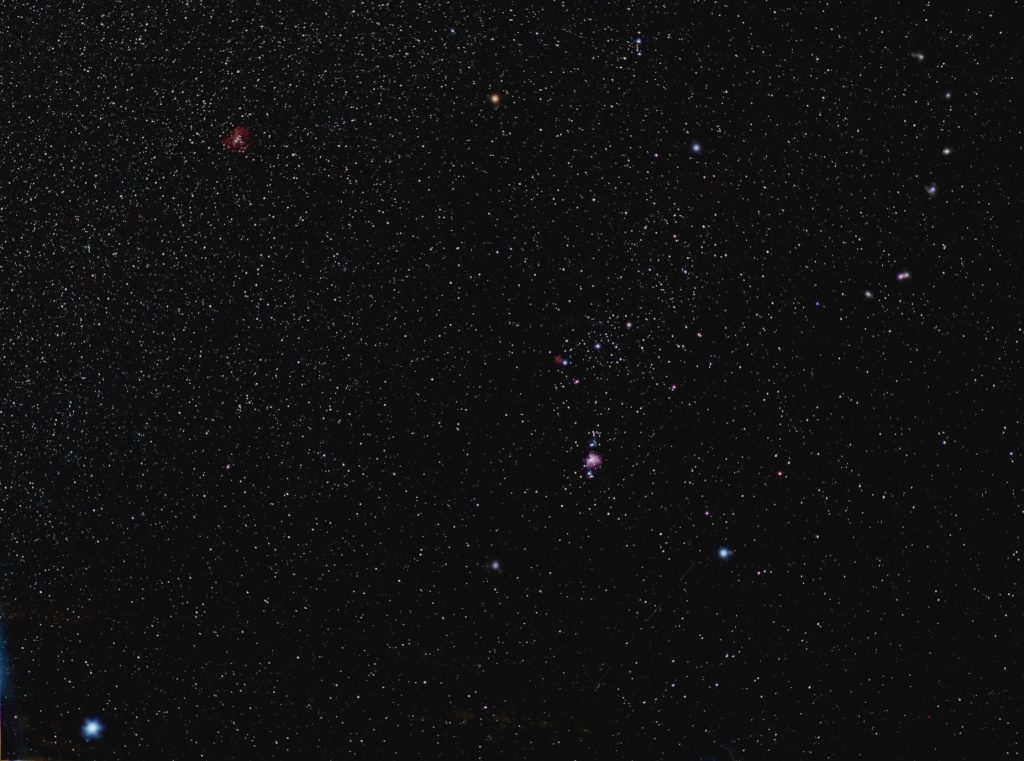
Orion with a 55mm lens
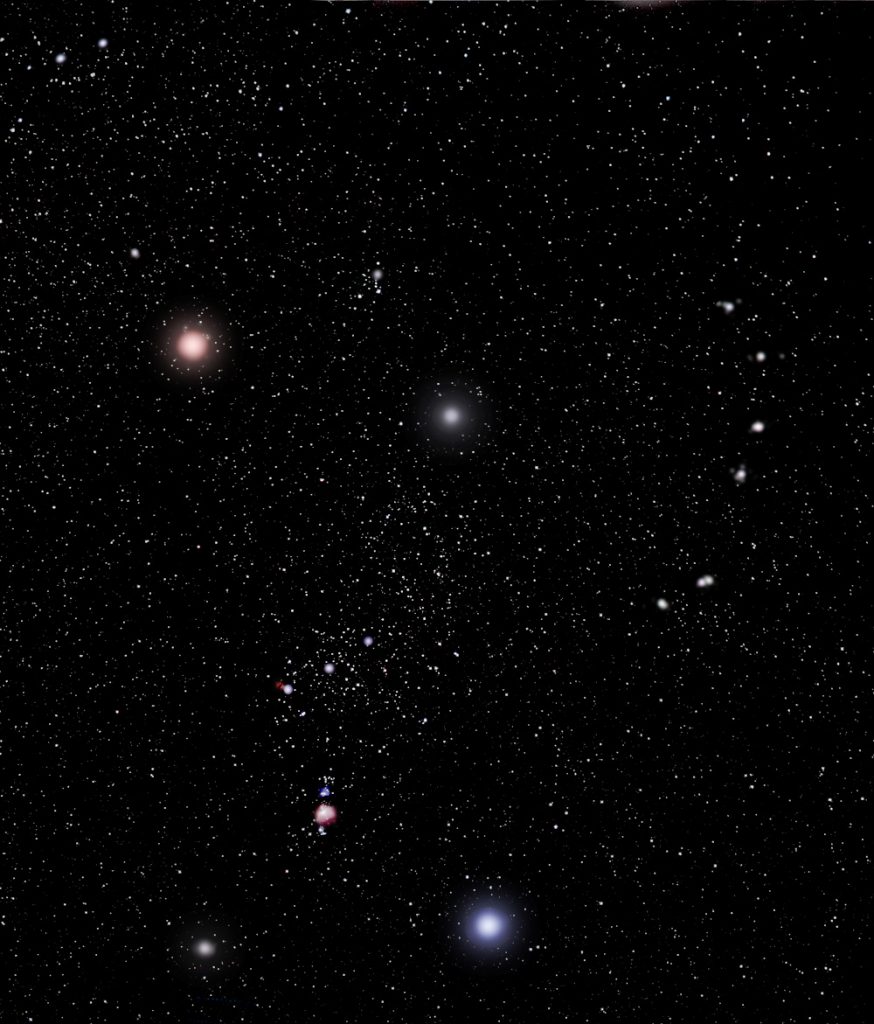
Sword of Orion with a 200 mm lens
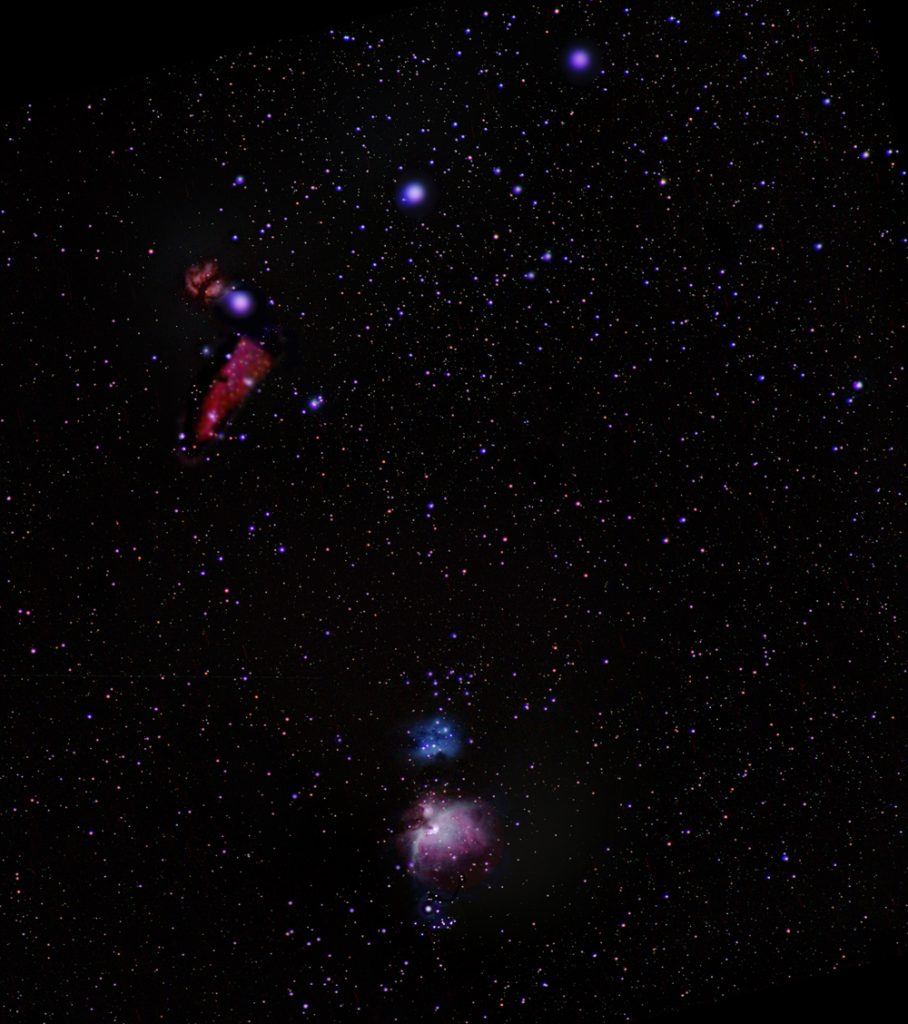
M42 region with a 400 mm lens
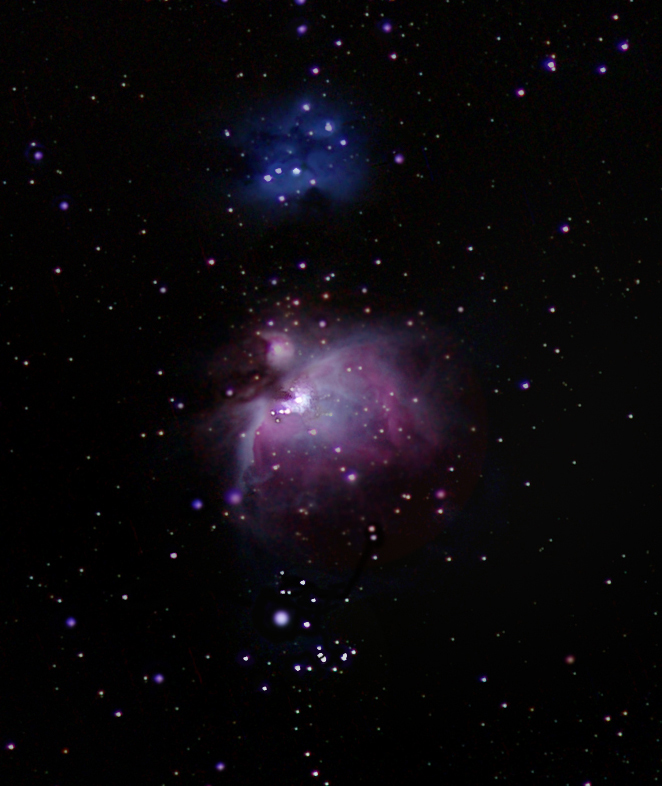
Pleiades and Hyades Clusters with a 75mm lens
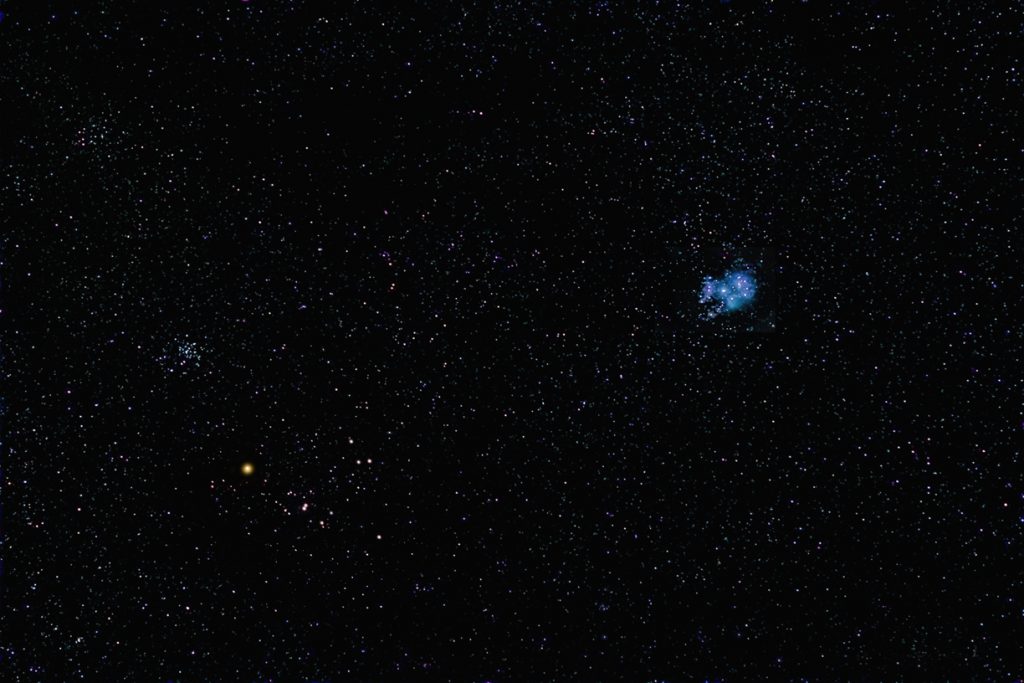
Pleiades Cluster with a 135 mm lens
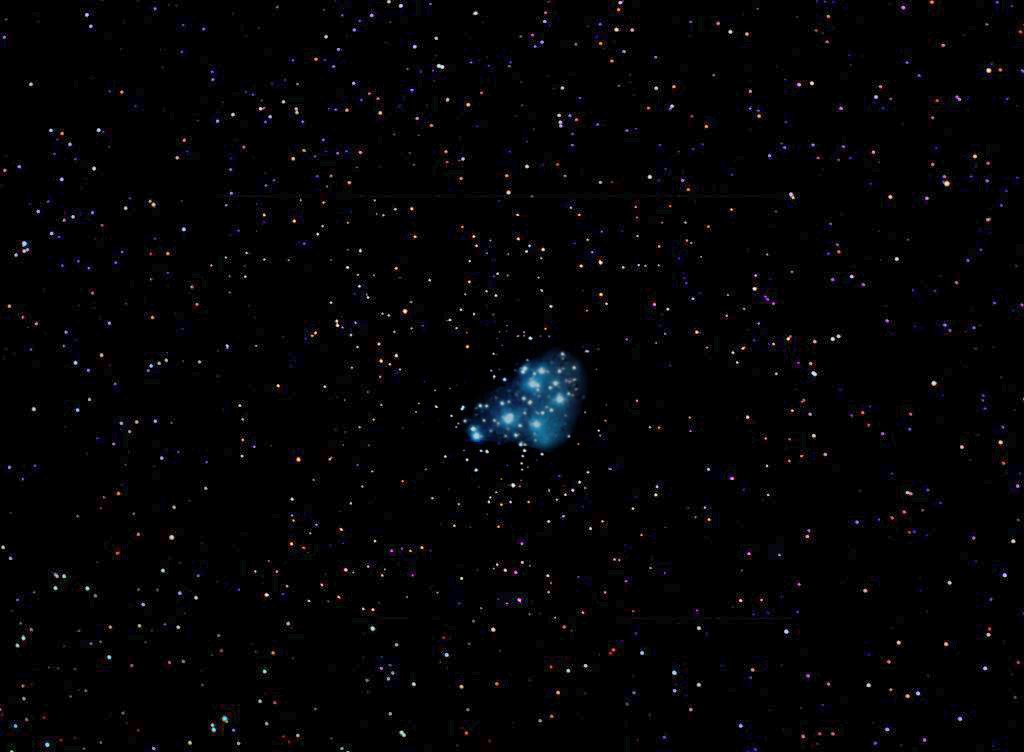
Pleiades Cluster with a 200 mm lens
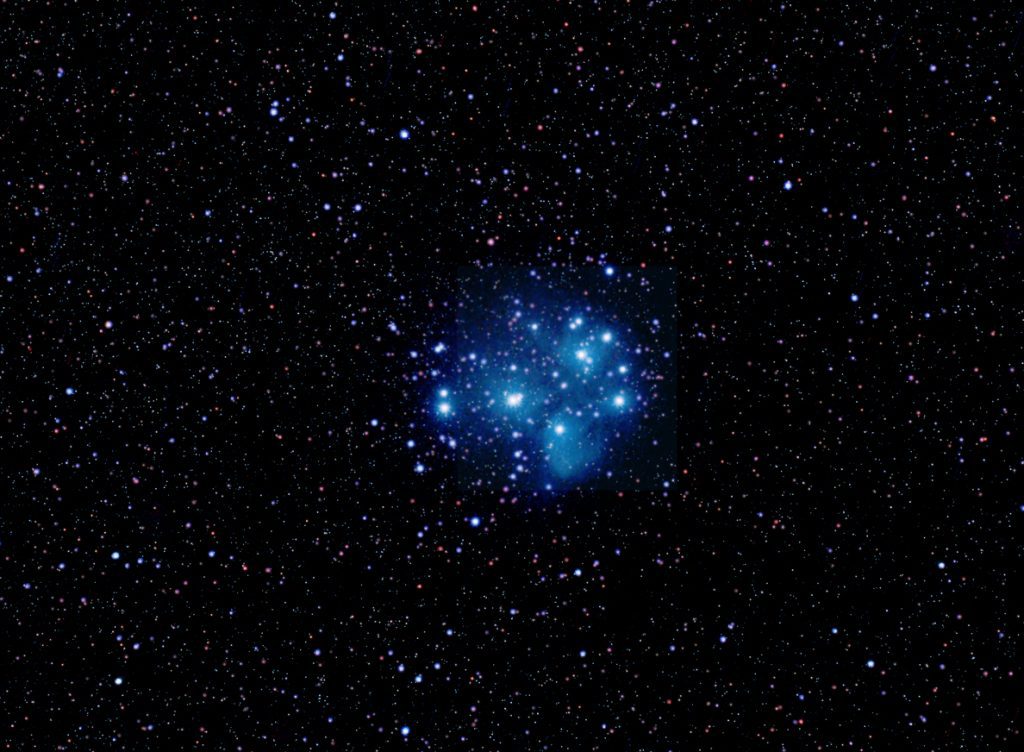
A bestiary of lenses (Ok, lenses are not animals, but the word can also be used to refer to a collection.)
Over many years, I have acquired many lenses for usein general photography; including those for my Nikon film camera later followedwith my D7000 APS-C and D610 full frame digital cameras. More recently I have acquired both Sony APS-Cand full frame cameras along with two Fuji APS-C cameras. For astrophotography use these are usuallycoupled with prime lenses, some modern but often with old manual ‘legacy’lenses. Only a few have been bought new.In the list below, I have noted the lenses that I have used forastrophotography which may help to guide you to what is available at reasonablecost, either new or second hand.
Fish Eye
An excellent such lens is the Samyang (Rokinon) 8mm f/3.5 lens which sports a diagonal field of view of 180 degrees. As one would expect, this lens produces lines that are wildly curved close to the edge of the frame, but as it employs a stereographic projection, images are more natural looking and objects near the edge of the frame are less ‘squashed’ than those when fish eye lenses employ an equal area or orthographic projection. An AE version is available for Nikon cameras and, at lower cost, a non AE version available for Nikon, Canon, Sony and Micro 4/3 cameras. This lens would be superb for time lapse imaging of the whole sky to capture meteor trails. [Particularly when used with a full frame sensor as described above.]
Ultra Wide Angle Lenses with 10 to 20mmeffective focal lengths
Anexcellent zoom lens is the Sigma 10-20mmf/3.5 which, set at 10mm so givingan effective 15mm focal length and mounted on my Nikon D7000 camera, producedone of my very best images as described in the ‘Startrails’ chapter. It has a constant f/3.5 aperture and isavailable for Nikon, Canon and Pentax DX cameras. Its diagonal field of view is 102 degrees at10 mm and 64 degrees at 20mm.
A widely commended manual, fixed focal length, prime lens is the Samyang (Rokinon) 12mm f/2 lens which is available to fit a wide range of mirrorless cameras such as those made by Sony, Fugi, Samsung, Canon, Panasonic and Olympus. I have used mine, mounted on a Sony A5000 camera, to produce wide field images of the Milky Way. This has an 18mm equivalent focal length on APS-C cameras.
Wide Angle Lenses with 24 to 35mm effectivefocal lengths
For use on full frame cameras I have Tamron Adaptall 24mm f2.5, Nikkor 28 mm f/3.5 and Nikkor 35mm f/1.8 lenses. The first ofthese was used with a Nikon D610 to make a vertical panorama of the northernMilky Way as imaged from the Kerry Dark sky reserve and described in thechapter ‘Imaging the Milky Way’. For useon my Fugi mirrorless APS-C camera I have a 7Artisans 25mm f/1.8 manual lens that is available at very low costfor APS-C and Micro 4/3 mirrorless cameras. It is a perfect lens for use with a Micro 4/3 camera but images will needsome slight cropping when used with APS-C sensors. I would highly recommend this lens as a firstprime lens to acquire for such cameras. Its image quality across virtually all the frame is superb. For my Sony A5000 camera I can also use a Sigma 19mm f/2.8 lens giving aneffective focal length of 28.5mm.
‘Normal’ Lenses with 40 to 55mm effectivefocal lengths
These are called ‘normal’ as they have a similar perspective as viewed by our eyes. The nominal focal length of such lens is the 50mm as, for example, the Nikkor 50mm f1/8. Another very sharp lens for full frame cameras is the Micro-Nikkor 55mm f/2.8 Macro lens. Such lenses are produced by every camera manufacturer and companies such as Sigma and Tamron. A superb ‘legacy lens is the Zeiss Contax-G 40 mm f1/8 Planar which, sadly, has now become quite expensive second hand. Used to take the 45 mm Sirius and Orion image above) and I have used one to make panoramas of the southern Milky Way. A more humble lens that can be bought for around 1/10th the price is the Russian Jupiter 8 50mm f/2 but which would need to be stopped down to ~f/5.6 for astronomical imaging.
For Olympusand Panasonic Micro 4/3 cameras, the tiny pancake Panasonic 20mm f/1.7 gives an effective focal length of 40 mm –apart from astrophotography it would make a superb ‘walk about’ lens. It is sharp from corner to corner and,coupled with a Panasonic GX1, has produced beautiful images of the southernMilky Way.
For APS-Ccameras having a crop factor of 1.5 or 1.6 (Canon), focal lengths of ~35 mmgive an effective focal length of 52.5. Ihave a Sony 35mm f/1.8 prime designedfor their DSLR’s and the very neat and well regarded Sigma 30 mm f/2.8 (so 45mm effective focal length)
Short prime telephoto lenses with 60-90mmeffective focal lengths
I havethree prime lenses for a full frame camera in this range, a Tamron f2.5 90mm macro lens, a Leica 90mm f/4 Elmar (this has,perhaps, rather a small aperture for astrophotography use, but gives surprisinglygood images at full aperture) and a beautiful Zeiss Contax-G 90mm f/2.8 Sonnarwhich is really excellent at f4.
There aremany lenses that can be used on APS-C cameras as the ubiquitous 50mm lenstranslates to 75 mm. The Nikon 50mm f1.8 lens gives excellentperformance when using an adapter as do those produced by virtually all cameramanufacturers. I also have an A-mount Sony 50mm f1.8 lens that can, as fortheir similar 35mm f/1.8 lens, be bought very cheaply second hand as few arecurrently buying the Sony DSLRs.
Medium to Long Focal length prime lenses 100 –300mm focal length
There aremany ‘legacy’ lenses that can be bought in this focal length range. At 135mm, I have a Carl Zeiss Jena 135mm f/3.5 lens which I can use with an m42 toSony e-mount adapter on my Sony DX and FX cameras. The Nikkor 200mm f/4 Ai which is a beautiful, all metal, lens that can nowbe bought quite cheaply second hand. Itis very sharp even at full aperture and near perfect at f/5.6. At the top end of this range is the Nikkor 300mm f/4.5. Again, it has a beautiful, all metal,construction and excellent optics which are near perfect when stopped down tof/5.6. Not surprisingly, it is somewhatmore expensive second hand.
For usewith an adapter on a mirrorless APS-C camera, the Tamron 90mm f2.5 lens gives an effective focal length of 135mm, theZeiss 135mm f/4 lens gives anequivalent focal length of ~200mm and the Nikon200mm f/4, 300mm.
Very long prime and zoom focal length lenses> 300mm focal length.
I only haveone prime lens in this category, an old SigmaAPO 400mm f5.6 lens bought for just £40. It is not highly regarded by some reviewers but I have found it to bequite satisfactory in use.
Recently Iacquired an optically stabilised zoom lens − the Sigma 150-500mm f/5 to f/6.3. This was bought primarily for nature photography, but it has been usedsuccessfully for imaging the Moon and planets (in skyscapes not in detail!) asdescribed in the chapter ‘Imaging with a fixed tripod’.